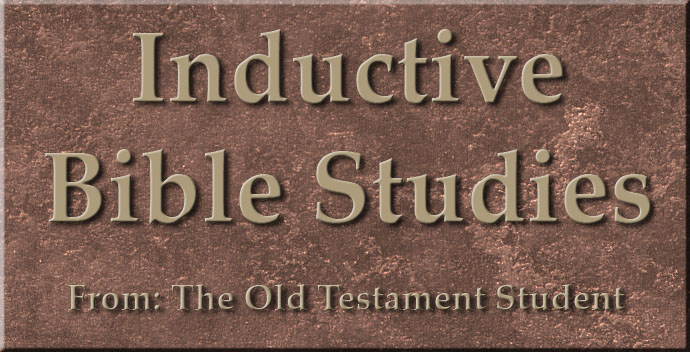
Inductive Bible Studies,
[Copyright by W. R. HARPER, 1887.]
PREPARED BY PROFESSORS W. R. HARPER (Yale University), W. G. BALLANTINE (Oberlin Theol. Sem.), WILLIS J. BEECHER (Auburn Theol. Sem.), and G. S. BURROUGHS (Amherst College).
|
Thirtieth Study.—The Prophecy of Nahum. [The material of this " study " is furnished by Professors Burroughs. It is edited by Professor Harper.]
I. PRELIMINARY NOTES. 1. The prophecy of Nahum finds its place at the close of the activity of Isaiah and Micah. It fittingly concludes the prophecy of the Assyrian period in Judah. Taking its stand upon the character of Jehovah, it emphasizes his justice toward the heathen world-power, as represented in Assyrian Nineveh. The character of Jehovah must condition his attitude and action toward the heathen, as well as toward Israel-Judah. Herein is found hope and comfort for his people. 2. The comparatively recent explorations in the East, uncovering the site and bringing to light the contemporary history of this heathen capital, together with the continued advance in Assyrian researches, cannot but render the study of this book peculiarly interesting and instructive. Nineveh, uncovered from her mounds, stands before us as she was in "the days of the prophet. Thus "the Bible and the Monuments are mutually interpreting one another. 3. The attention of the student is particularly called to the Book of Nahum as a specimen of Hebrew literature. Those who are interested in the literary study of the Bible may well devote themselves to a careful consideration of the form of this book. Such as can, even with effort, read it in the original, should endeavor to do so. Its striking beauties, however, may be quite thoroughly comprehended by a study of the English text of the Revision, aided by the suggestions of an appreciative student of the Hebrew.1 II. THE BIBLICAL LESSON.2 1. Read, carefully, in the Revision, the Book of Nahum, noting particularly the glowing descriptive style of the prophet. Observe his metaphors. Exercise the imagination as you read. Mark, as you proceed, such passages as are not clear. At the conclusion of your study of the biblical lesson, if these have not cleared themselves up, after thought has been bestowed upon them, consult a good commentary. Answer, from your reading, the following questions:
2. Re-read ch. 1. Make a particular study of the following points:
3. Re-read ch. 2.
4. Re-read ch. 3.
III. SPECIAL TOPICS. 1. The Prophet; his Birthplace; his Date.
2. The Style of the Prophet. What may be said as to the prophet's diction? What are the marked characteristics of his style? Do you find energy, beauty, clearness in his poetry ? Compare with the Book of Joel. What as to the connection of thought with thought, throughout the book? What as to the effect of the book as a whole upon the reader ? 3. Comparison with the Book of Jonah.4 Make a careful comparison of the Book of Nahum and that of Jonah.
|
|
 |
 |
|
1) Particular attention is called to the Hebrew (now O. T.) Student for October, 1882, containing the Hebrew text of Nahum, with translation of the same, together with translation of the " Septuagint, Targum and Vulgate texts, the work of the "translating committee of the exegetical class of the Hebrew Summer School of 1882. The form of the book is well brought out by Kleinert, Lange's Corn., "Nahum—" Consult also the literature given below. 2) The following literature may be consulted: Delitzsch, "O. T. Hist. of Redemption,"?60: von Orelli, "O. T. Prophecy," p. 311 seq.; Geikie, "Hours with the Bible," vol. 5, pp. 115-125; Keil and Delitzsch, Minor Prophets, "Nahum," C. F. Keil; Lange's Com., " Nahum," Paul Kleinert and Charles Elliott; Pusey, "Minor Prophets;" Smith's Bible Dict., "Nahum." The literature illustrative of the Book of Nahum is very extensive. The student is referred to Lange's "Nahum," Introd., and particularly to "The Literature of Biblical Assyriology," O. T. STUDENT, Feb., '88, Twenty-first Inductive Study, p. 195. From these extended lists, he may select such books as may be suited to his reading and may be accessible. 3) The sack of Thebes referred to is conjectuired to be its taking by Assurbanipal, known from the Assyrian records and located about 660 B. C. The prophecy of Nahum can hardly be placed earlier than under Hezekiah, after the departure of Sennacherib from Judah; its location in the times of Manasseh seems to fall in well with all the evidence in the case. 4) See the twenty-second study.
|
|
-
Site Navigation
 Home
Home What's New
What's New Bible
Bible Photos
Photos Hiking
Hiking E-Books
E-Books Genealogy
Genealogy Profile
Free Plug-ins You May Need
Profile
Free Plug-ins You May Need
 Get Java
Get Java.png) Get Flash
Get Flash Get 7-Zip
Get 7-Zip Get Acrobat Reader
Get Acrobat Reader Get TheWORD
Get TheWORD